Canadian market sees post-pandemic revival
13 May 2022
2022 is shaping up to be a solid year for the lifting, rigging and heavy haul market in Canada. Much better than 2021, in fact “night and day” different, perhaps.
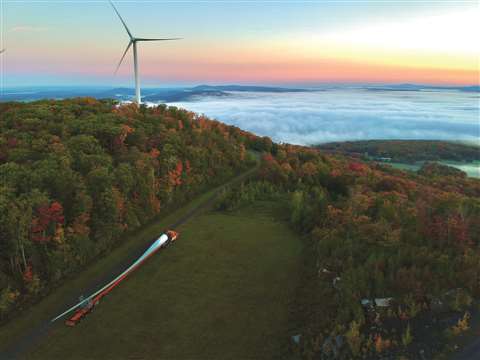 The Bellemare team hauled a 49 meter long wind turbine blade from a port to a wind farm project.
The Bellemare team hauled a 49 meter long wind turbine blade from a port to a wind farm project.
“It’s probably the biggest difference from one year to the next I have ever witnessed in my career,” said Ed Bernard, president, Precision Specialized. “I know for us, our 2022 will probably be the best year we have ever had. From our existing clients, spot quote wins, small and large projects, assets and our project logistics team, everything is warp speed. Our entire transportation group (under the GTI Group flag which includes GTI Canada, Nomade, GTI USA and Jetco) are experiencing similar market conditions.”
Bernard said that for the most part, 2021 was not a good year for his company or in general for the market in Canada.
“Project delays, manufacturing delays, we all know what 2021 was about,” he said. “But currently, 2022 has been amazing. Rate increases, an abundance of work from small one off moves to large projects, everything imaginable seems to be moving, and everyone wants to move it as quick as possible. Our approved orders and pipeline are filling into 2023.”
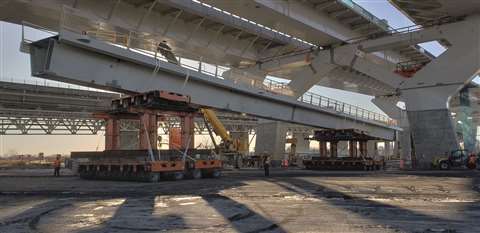 Bellemare provided rigging expertise on the new Champlain Bridge in Montreal, Quebec, Canada.
Bellemare provided rigging expertise on the new Champlain Bridge in Montreal, Quebec, Canada.
Bernard said that typical step-deck and double-drop work is leading the demand, followed closely by multi-axle work, which are the heavier and bigger loads.
Inflation, high oil and gas prices and supply chain issues are impacting the market and business development, but it’s been manageable.
“Definitely, we are feeling it like everyone else,” said Bernard. “From fuel, to parts, even bungee cords, everything is increasing in price. The time it takes to obtain most of our supplies has also increased. With that of course comes price increases for our rates as well. It is almost like everyone decided to raise prices for everything all at the same time.”
Obstacles that companies like Precision Specialized are facing are similar to those companies in the United States are facing.
“Infrastructure and lack of harmonization with weights and configurations for over-dimensional loads from province to province,” Bernard said. “We can load a 185,000-pound press with dimensions of 24 by 12 by 12 feet from Toronto to Baltimore or any Northeast port on one of our light-weight 13-axle configurations. But we cannot take that same load west of Ontario into Manitoba or any of the western provinces. Similar situations exist in the U.S., but it is more pronounced in Canada. One day, maybe we can all get on the same page and try to reduce the amount of differences to move freight of all sizes. It is in everyone’s best interest to do so.”
Bernard said that once you figure out what you can and can’t do and can deal with the issues where others can’t, your phone rings more.
“Manufacturers need it moved, if you can do it, again, where others can’t or struggle to do it, it’s a good thing for us,” he said. “We work with many of our colleagues from the SC&RA on loads coming into and out of Canada. Mostly because they are extremely busy, or the trailer configuration required is something they do not have. It is no different when we contact one of them for a 19-axle or dual-lane, it is something we do not have. It is a great partnership.”
Bernard said manufacturers in Ontario and Quebec are gearing back up. The west is seeing oil come to life in a big way, he said.
“LNG continues to grow in British Columbia, port work has increased like mad, especially with the delays in California,” he said. “The stronger U.S. dollar results in more exports from our manufacturers to the U.S., which means more transportation and more dollars for permits, fuel and all the things it takes for a truck to travel from Canada to the U.S. This also puts money not only into Canadian businesses, but many U.S. businesses as well.
Bernard is optimistic about the future.
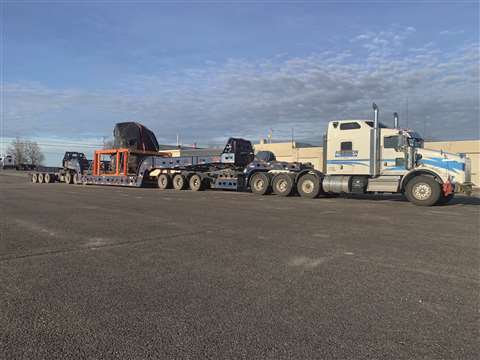 2022 is shaping up to be a stellar year for Precision Specialized, which recently hauled a motor from the Port of Baltimore to Tiverton, Ontario.
2022 is shaping up to be a stellar year for Precision Specialized, which recently hauled a motor from the Port of Baltimore to Tiverton, Ontario.
Busier than ever
Similarly, Kevin Kwateng, heavy haul operations manager for Bellemare, said business is busier than ever.
“We see it all as very promising right now,” Kwateng said. “The projects are getting bigger. The challenges are more complicated, and the timelines are getting shorter. But the opportunities are phenomenal. This is what will allow us to grow and become a bigger and better company and we are looking forward.”
As far as work in the highest demand, he said there’s definitely a lot of medium-sized machinery projects.
In Canada, there’s a lot of infrastructure construction so that means there’s a lot of steel and concrete beams to transport to support rapid bridge construction, he said.
“A lot of plants are refurbishing equipment and doing shutdowns,” he said. “We are seeing a lot going on in the renewable energies and wind sectors. Most sectors are up. Mining is still probably the slowest sector.”
Inflation and rising equipment prices have impacted the Canadian market in numerous ways, Kwateng said.
“Today, our customers are not necessarily asking us what is your price?” he said. “Instead, they are asking ‘What is your earliest availability?’ They are willing to pay to have us be there whenever they need us. Our customers are so busy that the quicker we can get to them, the quicker they can turnaround to a new project or move equipment out of their fabrication shops. Now it’s a matter of partnering up with who they can get to achieve a quality and timely service and not slow down.”
Kwateng said it appears things are full steam ahead.
“I think things are only going to get busier,” he said. “The market is now coming full force, and things are more in control. People are more comfortable with the Covid situation and learning how to live with it. We see more willingness to travel and manage the risks. This is adding to demand. Demand is high and will be for a while.”
There are still challenges in the market, and for Bellemare, the big obstacle is personnel.
“It may cost more money to get steel, but you can get it,” he said. “But having certified manpower that knows how to operate equipment and operate it well, this is hard to achieve. We don’t find them coming out of college, and the good ones already have good jobs. It’s really difficult to get someone on board and give them the time they need to grow into their position. Right now, it’s all hands on deck. It’s harder to expand business when you don’t have the right personnel.”
But the positives in the market rebound in Canada outweigh the bad.
“We are moving past Covid, and we are still alive,” he said. “I mean that whole heartedly. People have lost loved ones and colleagues. Companies have failed and don’t exist anymore because of Covid. So, we are lucky we are still here and have our health and a healthy business. We are thankful because we survived and now, we feel like we can survive anything.”
Economic boost
Guillaume Gagnon, executive vice president of Guay Inc., characterizes the Eastern Canada market as “high demand.”
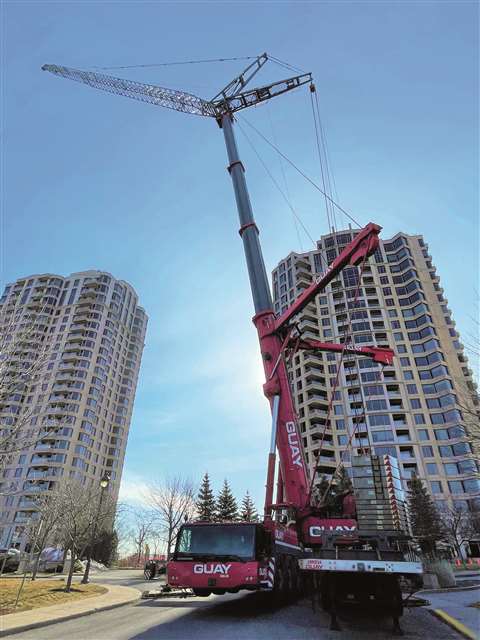 Guay uses its Liebherr LTM1500 on projects throughout Eastern Canada.
Guay uses its Liebherr LTM1500 on projects throughout Eastern Canada.
“The economy has been boosted by the government on lots of construction projects and low interest rates,” he said. “There is a shortage of crane operators.”
Civil infrastructure, building construction, mining and wind turbine maintenance projects are in most demand, Gagnon said.
“[There is] no energy construction but [it] should start back in the near future,” he said.
High oil and gas prices and supply chain issues are impacting the market, but the industry is still thriving.
“Yes, we see high prices for oil and gas,” he said. “Our cost of operation and maintenance have risen a lot. There is also higher delay on getting parts and new cranes delivery, which impacts our availability and forces us to always review our schedule.”
He said rising interest rates, inflation, rising worker wages and a worker shortage will be a challenge.
“With inflation, oil and gas prices and supply chain impact, we will have to work on price increases and focus well on keeping the control on our expenses,” Gagnon said. “On the labor side, we will focus a lot on our hiring new employees but also keep our actual employees satisfied.”
The Crane Rental Association of Canada (CRAC) Annual Conference will return as an in-person event May 17-19 at the Queens Landing Hotel in Niagara on the Lake, Ontario.
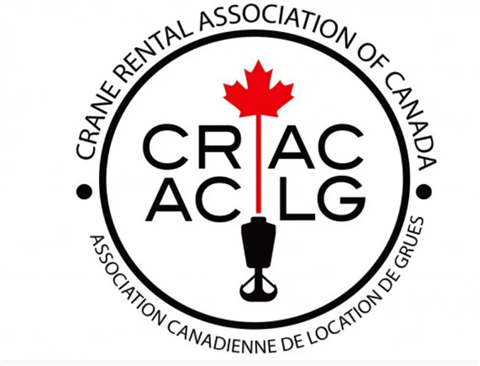
The three day conference includes business meetings and seminars pertinent to the crane rental business in Canada, as well as golf, tours and networking events.
A first for CRAC is the Canadian Lift of the Year Awards that recognize excellence in the Canadian crane industry. There are two categories: Under 20 metric tons and Over 20 metric tons.
■ For information about registration please visit https://crac-aclg.ca/welcome/ or to watch the conference virtually visit: https://crac-aclg.member365.ca/public/event/details/0dc86efca50203b0c390c858ccda5d5e9e650dbd
STAY CONNECTED


Receive the information you need when you need it through our world-leading magazines, newsletters and daily briefings.



